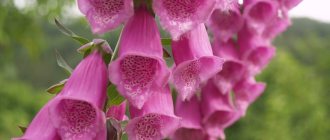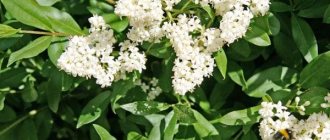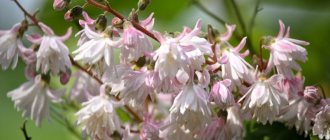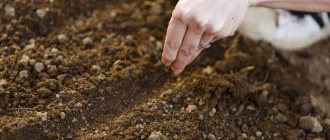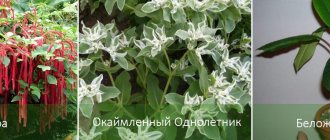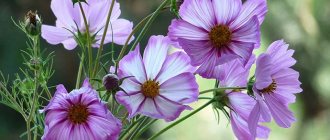Description of the episode
Belongs to the Gesnerieceae family. The genus Episcia contains about 30 species. The showy plant with brightly colored and textured foliage goes by many names - Peacock Flower, Violet Flame, Chameleon Plant, African Violet.
A spectacular miniature plant with whitish-pink leaves will decorate any collection of house plants
In nature, it is found in the tropical forests of Brazil, Mexico, Colombia and the Antilles, where twilight reigns even at midday. Apparently, this is why the flower has such a name - shaded. It grows under bushes in the form of a low-growing creeping grass with leaves collected in a rosette and numerous shoots.
The tropical flower is also grown as an indoor plant. It is not capricious, has a long flowering period - from early spring to autumn. But it places increased demands on heat and moisture.

Abundant flowering begins in spring and ends in autumn
Episcia is usually grown as an ampel. Young shoots initially remain vertical, but over time, when many long (up to 40–60 cm) lateral shoots grow, they lie down and form a beautiful cascade.
Beauty episcia - video
Episcia varieties with photos and descriptions
More than a hundred varieties of episcia, bred on the basis of just three varieties, provide wide scope for experimentation in indoor floriculture. Hobbyists create spectacular compositions by planting Episcia with different shades of leaves and bright flowers, which together look simply mesmerizing. We list the most popular indoor varieties.
Episcia cupreata

Episcia cupreata photo
This type of episcia is especially pleasant due to its large velvety leaves with a fine network of veins, making the dissected pattern three-dimensional. The leaves have small teeth along the edges and a spotted dark burgundy color on a lighter light green-silver background. Other shades are also possible. The flowers are bright scarlet, on a tubular stalk with wide open petals.
Episcia Chocolate Soldier
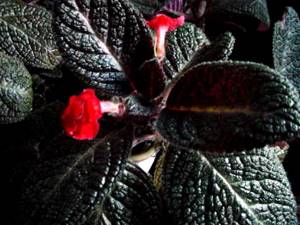
Episcia Chocolate Soldier photo
Thick corrugated leaves are striped with a network of veins, making the leaf plate voluminous and embossed. The variety has an unusual green-purple hue of leaves and long-lasting abundant flowering.
Episcia forest beauty Episcia Silvans Beauty
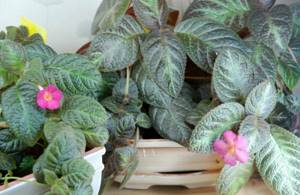
Episcia forest beauty Episcia Silvans Beauty photo
The delicate silver-lavender with blue tint of the leaves captivates with its unique beauty. Expressive veins enhance the showiness of the leaves. The flowers are rare, small, pale pink, and look very elegant.
Episcia Northern Lights
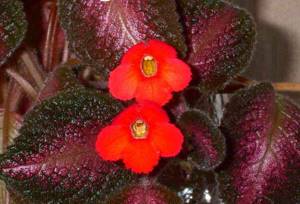
Episcia Northern Lights photo
The stunning combination of lilac-gold and dark green and brown shades truly resembles the Northern Lights. The fluffy leaves have a fine pattern of cross veins, and the bright scarlet flowers blend harmoniously with the overall color scheme.
Episcia Silver Sheen
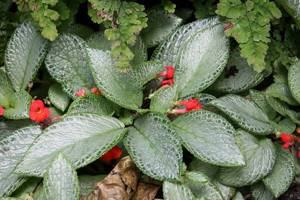
Episcia Silver Sheen photo
The elongated oval-pointed leaves of a soft light green color have a silvery coating on top. The bushes are spread out, squat, between the leaves, as if under them, rare scarlet flowers are hidden.
Episcia reptans

Episcia reptans photo
The plant spreads along the ground, growing due to underground shoots and tendrils, covering the surface of the earth with a continuous carpet of velvety leaves of dark green and burgundy shades. The soft pink flowers contrast very nicely with the rich dark leaves.
Episcia dianthiflora
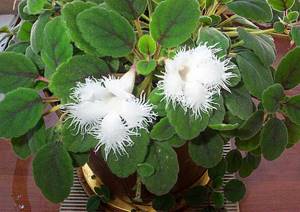
Episcia dianthiflora photo
A plant with lush foliage. The leaves are rounded, with soft grooved edges. A central network of dark purple veins runs through the center of the dark green velvety leaves. The flowers are white, large, up to 5-6 cm in diameter, with dense hairs along the edges of the petals, making them slightly reminiscent of carnation flowers.

Episcia care at home reproduction in the photo variety tropical night
Varieties
At home, Episcia copper and Dianthus are most often grown, less often creeping, as well as numerous varieties obtained from these species.
Over a hundred varieties have been bred, and each has a unique color and unique pattern.
Episcia copperata is characterized by creeping shoots. Large (up to 15 cm long) oval leaves, pubescent, olive green with a light stripe along the vein. The underside of the leaf blade is reddish, with a white dividing stripe. The flowers are small (2 cm in length), bright red with a yellow throat.

Copper-red episcia is used to breed new varieties
Episcia dianthus has two types of shoots: short branches with leaves and long “mustaches” with rosettes. The leaves are less expressive, small (3 cm long and 2 cm wide), pubescent, green, with rounded teeth at the edges, and a burgundy midrib. The flowers are white, speckled along the throat, fringed.
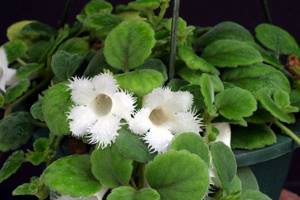
The corolla of a snow-white flower is fringed along the edge of the limb
Episcia repens, which has creeping shoots, is grown only as an ampel. The leaves are long (5–10 cm), green or brown, with patterns and spots on the edges. The flowers are red with a pink throat.

Episcia repens is more valued for its decorative leaves.
Increasingly, flower growers are paying attention to new varieties.
Examples of varieties in the photo

On one plant, flowers can be yellow-pink, pink and yellow with pink dots
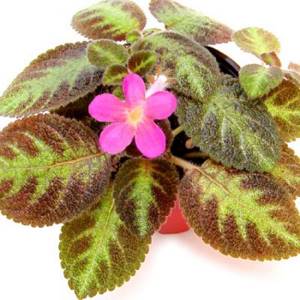
Decorative foliage with a light green pattern. Flowers dark pink

Bright pink flowers with delicate green and pink leaves
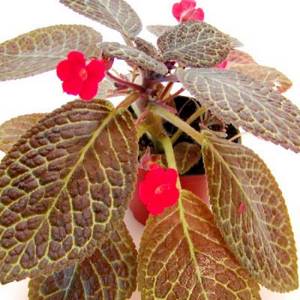
Silver-brown foliage is decorated with pink weaving. Red flowers
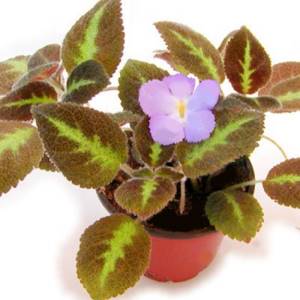
Green-brown leaves are decorated with light specks

Variety with velvety green patterned leaves and lilac flowers
Description of variety name and photo
Copper Episcia is a very popular species in floriculture with olive green leaves and brown edges. Their length is 7-10 cm, while the color of the base and veins varies very significantly in relation to one or another variety, of which there are many. In flowers of red or yellow color, the tubes are most often yellow, the lips are colored orange. The plant is characterized by an erect position up to a height of 15-20 cm.
Developed on the basis of this species, the episcia silver sheen is characterized by orangish-red flowers and bright silver-green folded leaves with a copper edging.
Episcia lilac - has common features with copper, but with a much smaller variety of varietal forms. The foliage is jagged, reddish-purple (red in the lower part of the volume) with different colored veins, and the flowers are pale lilac or blue, larger than copper, and with serrated edges.
The varietal form of Episcia blue nile is marked by large blue flowers with a lavender tint ( Episcia blue or blue , that is, with blue or blue flowers, is rare among varieties) with a yellow center and brownish-green foliage with strong pubescence and a wide olive-green stripe on the middle veins.
The fast-growing, small-leaved hybrid variety Episcia Silver Skies has entirely silver foliage, making the bright orange-red flowers stand out against its background.
Episcia dianthus is notable for the fact that it is ampelous. Its dense, ellipsoidal, velvety small (length - 3 cm, width - 1 cm) bluish-green foliage covers stemless rosettes and oblong shoots rooted at the nodes. The tube-shaped shape of large white flowers with fringed petals creates a similarity with carnation flowers.
Episcia repens colors its foliage depending on the conditions of its detention. In shaded conditions it is silvery-green, and when, on the contrary, the lighting becomes strong, it turns brown. This effect is endowed with both the species itself and its hybrids. The flowers are scarlet, fringed at the edges.
Episcia varietals
In addition to those listed above, several other varietal epicions are also widely known:
- For example, Episcia pink panther is very popular due to its ease of care and large dimensions, its flowers are large, bright pink, and its foliage is lime-green (sometimes bronze-green), up to 15 cm long.
- The Episcia pink acaju variety is distinguished by silver-green foliage with inclusions in the form of whitish-green stitches and pink splashes, and orange-red flowers with a yellow throat.
- Episcia tiger stripe tiger episcia common in Moscow , differing only in smaller foliage and silvery veins (in the “Muscovite” they are golden).
- Episcia strawberry patch variety has small, sharp leaves, painted in a bright pinkish-red color, and the flowers are scarlet with a yellow throat.
- Episcia chocolate cream is characterized by red flowers and silvery-brown foliage with pinkish netting.
- Episcia Ronnie variety has a special beauty - the coral-red hue of the flowers effectively complements the chocolate-brown color of the foliage with silver-green veins.
- The large Episcia degas has red flowers and brown-green leaves that “dissect” deep greenish veins.
Comfortable growing conditions - table
| Lighting | Episcia is a light-loving plant. She needs bright but diffused light. In the open sun, decorativeness decreases: the leaves lose their variegated color, the inflorescences dry out. The most comfortable place for the epission will be on the east or west window; you can also place it on the north side. But in low light, flowering will not be as long, the lashes of stems will stretch, practically not forming lateral shoots. On the south side, the flower is placed away from the window or diffused light is created by covering it with a light curtain, especially during the period of active sun - from 10 a.m. to 3 p.m. You can also keep the flower on shelves under artificial lighting, and the duration of daylight hours increases significantly. |
| Humidity | The abode of tropical forests has special requirements for air humidity. However, the leaves should not be sprayed so as not to cause them to rot. The flower pot can be placed on a tray with wet pebbles or placed close to the aquarium. Be sure to carry out regular, even watering. |
| Temperature | The optimal summer temperature is +20–25°C. The plant easily tolerates even extreme heat (+35), provided that a humid atmosphere is maintained. In winter, the room should also be warm - no lower than +18, otherwise the flower will simply die. |
| Fertilizers | In the spring-summer period, they are regularly fed with complex and organic fertilizers every two weeks. |
| Transfer | The rapidly growing episium is transferred annually to larger containers, adding fresh soil. Once every 2–3 years, the soil composition is completely replaced. |
| Trimming | To give the plant a beautiful appearance, overgrown shoots are regularly pruned, forming neat bushes or ampelous compositions. |
| Reproduction | Propagated by seeds, leaf cuttings, lateral shoots. |
How to care for a houseplant?
Lighting
Episcia is a plant that needs diffused light. Therefore, you should not leave it on southern windows, where the leaves may be exposed to direct sunlight. If there is no other option, then you should shade the flower from 10 a.m. to 2 p.m.
Northern windows are also not suitable for the plant: here it will lack light. During the period from mid-autumn to spring, when daylight hours are short, it is optimal to illuminate the episium with phytolamps or other devices.
Temperature
The flower feels great at room temperature. If indoors:
- below 16˚С - will die;
- 18-25˚С - normal growth and development;
- 25-35˚С - can exist with sufficient humidity;
- above 35˚С - it will die.
REFERENCE! Episcia is comfortable in the same conditions as humans.
Watering

The plant needs abundant watering: the soil should not be allowed to dry out.
But you shouldn’t allow water to stagnate either. It is optimal to water when the top layer of soil dries out (about once every 2-3 days).
In winter, this should be done a little less often - once every 4-5 days. You need to use settled water at room temperature and do not allow water to get on the leaves - they will begin to rot.
Therefore, bottom watering will be more convenient. There is no need to spray the epicion.
Humidity
The flower needs high air humidity. Young plants are especially demanding of this parameter; after watering, they should be covered with film.
To ensure optimal conditions, you can place the pot with episcia in a tray with wet pebbles , expanded clay or sphagnum moss. In the case when the plant is suspended, the same materials must be placed in the gap between the flowerpot and the container with the flower.
How to fertilize?
Episcia needs fertilizer only during the period of active growth. Therefore, in spring and summer it should be fed once every two weeks in small doses. Mineral and organic fertilizers should be used in a concentration 50% lower than indicated in the recommendations. Suitable for flowers:
- during the flowering period - fertilizers for flowering plants (“Etisso”, “Compo Sana” “Florovit”);
- the rest of the time - complex mineral (“Hesi Phosphorus Plus”, “Agree’s”, “Multiflor Aqua”) or organic (bird droppings, compost, humus) fertilizers.
Trimming

Episcia grows very quickly, so to maintain the density and lushness of the plant, you need to resort to pruning.
- Creeping shoots should be removed regularly, otherwise the flower will grow and look untidy.
- It is necessary to cut off the escaped shoots with daughter rosettes, this will give the episcia a beautiful shape.
When forming the crown, you should not allow the shoots to hang from the pot: they will rub against its edge.
To avoid this, you can install a trellis 15-20 cm high and attach shoots to it as they grow. This will give the plant a beautiful shape.
Reproduction
Episcia can be propagated in four ways: seeds, cuttings, rosettes and leaves. Inexperienced gardeners are better off choosing one of the vegetative methods and not having to worry about germinating seeds. A mixture of soil and sand in a ratio of 3:1 is suitable for planting.
REFERENCE! The planting substrate must be moist throughout the entire germination or rooting period.
Seeds
With this method, you need to take into account that new plants do not retain the varietal characteristics of the parent, that is, the color of the leaves and the pattern on them can be anything. Seeds should be sown on a damp, disinfected substrate and, without covering with soil, covered with film. Ventilation is necessary once a day. Shoots will appear in 25-45 days.
Cuttings
A young shoot with three to four nodes is suitable for use as a cutting. Moreover, it should not have lateral processes. The cuttings can be placed in water until roots appear or immediately planted in a small pot. Then you need to cover it with film or a jar.
Rosettes
In spring, a young rosette of the first order with 4 developed leaves should be planted in a small container without cutting the tendril from the mother plant. There is no need to bury it - just bury the bend of the stem 2-3 cm. You can secure the rosette using a pin or a weight.
At first, the seedling needs greenhouse conditions. Within 7-10 days the rosette should take root, then the tendril can be cut off and transplanted to a permanent place.
REFERENCE! Episcia is capable of producing whiskers from the first year of life.
Leaf

After 3-5 days the first roots will appear. Then you should plant it in a small pot. It will take several months for new leaves to appear. In this case, the mother leaf will gradually wither and darken, giving strength to young shoots. You can’t tear it off, you have to wait until it falls off on its own.
Seedlings must be kept at a temperature of 23-24˚C and transplanted once a month into larger containers. The largest pot sufficient for an adult plant is 20 cm in diameter. The young flower should be carefully protected from the sun for a month.
Planting and transplanting
Good development and flowering is promoted by replanting the plant and renewing the depleted soil.
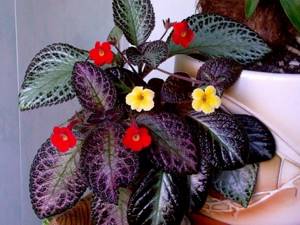
For abundant flowering, the plant is transplanted into new soil.
Priming
Episcia prefer a light and airy growing environment. The soil should have average acidity (pH 5.5 - 6.5). The soil mixture is prepared from leaf soil, peat and river sand (3:1:1), adding sphagnum moss and ash. A slightly acidic substrate for violets is also suitable.
The containers are selected to be low and wide. Expanded clay and crushed polystyrene foam are placed on the bottom as a drainage material in a layer of 3 cm.
Espicia feels best in a low and wide pot.
Replanting a flower: a step-by-step guide
The flower grows very quickly, so every spring it is transferred, without disturbing the integrity of the earthen clod, into a larger (2-3 cm) container. The maximum diameter of the pot is 18–20 cm.
Every 2–3 years the plant is replanted, completely renewing the soil.
- Before transplanting, the flower is watered. Carefully remove from the pot.
- Carefully inspect the roots. Remove dried or rotten areas.
- A layer of drainage is placed at the bottom of the container. Fill in the prepared soil.
- A flower is planted and watered.
Transplantation and transshipment - video
Variety of species
Rose mix - what kind of houseplant is this?
Episium Tiger Stripe grows slowly, adapts well to arid zones and blooms profusely even if it has to exist in a very poorly lit city apartment.
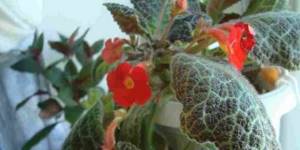
Tiger Stripe
The flower strongly resembles Episcia Tiger, which has spread widely throughout Moscow. You can distinguish one plant from another by its foliage. The leaves of the Tiger Stripe are smaller in size with silver veins, while the Muscovite flower is riddled with veins of a golden hue.

Northern Light
Episcia Northern Light (Northern Lights) is a hybrid of Episcia copper. The green foliage of the plant is pubescent with a silvery coating and bordered with brown specks. The flower stalks of the Northern Lights are orange-red.
The Emerald Velvet variety has large, jagged, pubescent emerald-pearl foliage spotted with olive-brown velvety speckling. Episcia Emerald Velvet blooms with soft lilac flowers with a white center. From a distance, the flowers of the plant appear blue.
A miniature variety of episcia, the Silver Skies variety, can be recognized by the silvery coating that appears on some areas of the green leaves of the plant and its bright carmine-colored flowers.
Note! Silver Skies is often confused with Episcia dianthus.
Episcia Luther or Blue Nile is a stunning combination of lavender-blue, yellow-centered large flowers and fluffy brownish-green foliage. The midrib of each leaf is decorated with an olive-green stripe.
Strawberry Patch, Strawberry Haze - this is the name of the hybrid variety of Episcia Strawberry Patch. The small pointed leaves of the plant are colored reddish-pink. During the flowering period it is covered with scarlet flowers with a yellow center.
The leaves of Episcia Jim Bodnar (Jim's Red Trail) are dark brown and dark olive. The pubescent, rough foliage of the Red Trace is permeated with red-pink mesh. The flowers of this ornamental plant are orange-red or pure red with a bright yellow core.
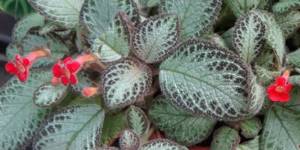
Silver Sheen
Episcia Silver Sheen is a hybrid of Episcia Cupreata. Blooms orange-red. The foliage of the plant is wrinkled, colored silver-green and edged with a copper-colored edging.
The leaves of Episcia Strawberry Mist are pale pink in color. Here and there, light green highlights appear through the soft pink surface. Episcia Strawberry Mist flowers can be red with an orange center or orange with a red neck.
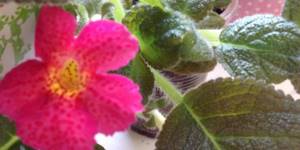
Raspberry Blush
The leaves of Episcia Raspberry Blush can be plain, dark green with pale veins, or shiny, glossy with light purple veins. It blooms with red flowers with a yellow center. Novice gardeners sometimes confuse this variety with the Pink Panther.
The large foliage of Episcia My Precious (My Precious) is painted in a rich green color. It is lumpy, glows with a glossy sheen and is decorated with silvery-pearl veins. The yellow color of the plant's flowers thickens at the throat.
The flowers of Episcia Sea Foam are orange, and the foliage is very light, large, silvery green with a pink tint in the center and red around the edges. Each leaf is framed with a dark brown edging.
The velvety, dark green foliage of Episcia Aloha Mauna Loa with pearlescent veins of bright pink color closer to the center is shimmering with bright green. The flowers of the plant are red-orange with a yellow center.
The soft green leaves of the Yellow Mist episcia are slightly pubescent and covered with a silvery coating along the central vein. During the flowering period, the plant is covered with bright yellow flowers.
Lilacina Viridis is decorated with velvety, fluffy, emerald green foliage, silvery at the center and edged with a jagged fringe at the edges. The flowers of this variety are large, lavender-blue with a yellow throat and jagged, clove-like edges.
The coral-red flowers of Episcia Ronnie are a striking complement to the chocolate-brown foliage, riddled with silvery-greenish veins.
Epistomy care at home: what to consider
In order for the episcia to fully reveal its decorative qualities and bloom magnificently, a number of requirements must be met.
Watering
In spring and summer, regular watering is required, once every 3-4 days. Excessive watering or watering with cool water can cause disease. Water the plants through a tray or at the roots until water begins to penetrate through the drainage holes. After a few minutes, excess water is removed from the pan.
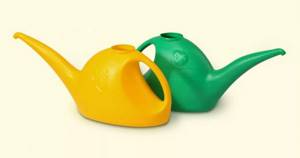
With the help of such a watering can it is convenient to water plants without splashing water on the leaves
In winter, watering is carried out less frequently, 1–2 times a week, when the surface layer of soil dries out. Use warm soft water.
Moisten the soil carefully so that drops do not fall on the leaves. A watering can with a long spout will be useful for this. Water is added along the edge of the pot or bottom watering is used.
A guest from the tropics needs a humid atmosphere. For this purpose, carry out regular spraying near the flower, in no case wetting the leaves. You can increase the humidity by placing the pot on a layer of wet gravel so that its bottom does not come into contact with water. Small aquariums that maintain a humid microclimate are often selected for growing watercolor epicions. The flower pot is placed on a bed of moistened sphagnum moss. The soil surface can be decorated with colored pebbles.

When planting watercolor epicions in small aquariums, a humid microclimate is created
Feeding
Feed in summer and spring, combining organic matter and mineral fertilizers. At the same time, the soil is enriched, plant growth is enhanced, and their immunity is increased. Before fertilizing, be sure to moisten the earthen ball.
You can use complex fertilizers for flowering plants, available in liquid form, granules and powders. In a liquid state, nutrients are better absorbed. Doses must correspond exactly to the instructions. In autumn and winter, fertilizers are not applied.
Among organic fertilizers, it is good to use ash containing potassium, phosphorus, magnesium, calcium, iron, and zinc. It is mixed with soil when replanting plants or used as a liquid fertilizer (1 tbsp per 1 liter of water).
Actively stimulates flower growth and a yeast nutrient solution: 10 g of yeast and 1 tbsp. l. sugar is dissolved in 1 liter of warm water, left for 2 hours, diluted 1:5 and fertilized the soil.
Recent Entries
5 working ways to use tar in the garden 7 indoor plants that help you get married even in adulthood Indoor plants that can bloom in trouble

Leaves are the main decoration of episcias
You can also fertilize with onion infusion: 50 g of onion peels are boiled in 2 liters of water for 10 minutes, left for 3 hours, cooled and filtered.
You should not go to extremes and feed your green pet too generously. The main thing is to observe moderation.
Growing tips - video
Episcea: maintenance and care
To keep an episcea flower in an apartment or country house does not require much effort or knowledge. Even someone who has never cared for plant crops can take care of the epiphys at home, that is, there will be no special problems. Living conditions should be as similar as possible to the natural environment where the perennial lives. To create them correctly, you should take into account several parameters; let’s look at each of them in more detail.
Location
The best option would be to place it on a windowsill or other place with constant light, which is required for normal growth. Without it, the leaves will dry out and curl, and new ones will be small. If it so happens that the perennial is placed in a flowerpot near the window, then direct exposure to the sun's rays is not allowed.
Optimal temperature
The tropical guest feels great at temperature conditions of about 24 degrees. When caring for episcia, you should not allow it to fall below 20°C, since at 16°C it dies. High rates are tolerated calmly if enough moisture is obtained. In the cold season it is necessary to protect from wind and drafts. The room should be bright, otherwise the shoots become elongated. The shade is lost from direct sunlight, so you should pay special attention to finding a good place.
Soil moisture
Watering in the warm season should be done at intervals of 2 to 4 days, while making sure that the soil is not too wet. This can cause root rot. In winter, the frequency of watering should be reduced to one or two weekly. In this case, you need to pay attention to the outer soil layer, which should not be dry in summer. When drying it during the cold period, the procedure should be carried out after waiting a couple of days. When watering, try not to touch the leaves with water to avoid damaging them. Spraying is not recommended at all.
Land for planting and fertilizing
The soil in which the perennial will grow must allow air to pass freely. The roots require this for proper development. To loosen the soil, you can place drainage in it, which will serve well as expanded clay or small stones. The drainage layer is located at the bottom of the pot. The food needed for planting can be purchased at the store or made with your own hands. If the second method is chosen, then you need to mix leaf and garden soils with river sand in equal proportions. An excellent additive in this case would be charcoal.
The plant should be fertilized once a week in spring and summer. In other seasons, it does well without feeding, which, on the contrary, can interfere with normal growth. You can use any mineral fertilizer for flowering plants, placing half the amount specified in the instructions into the soil. Dry soil should not be fertilized, as this may damage the rhizome.
Reproduction
The flower propagates well by stem cuttings, leaves and seeds. During seed propagation, varietal characteristics are lost.
The easiest way is to separate a young rosette with 4 leaves from the mustache, place it in a plastic glass, pressing it to the ground, water it, cover with film. After 10 days, roots will appear, and the rosette is planted in a permanent place.
You can root with a mustache without cutting it off from the plant. The hanging shoot is lightly sprinkled with earth. After rooting, it is separated and replanted.
Side shoots
The flower is easily propagated by lateral shoots:
- A shoot with 3–4 nodes without lateral shoots is lowered shallowly into water with activated carbon or dropped 1–1.5 cm into moistened soil and covered with film.
- The greenhouse is regularly ventilated.
- The shoot takes root within 7–10 days. After the roots appear, young plants are planted in the substrate.
- Every month the growing flower is transferred to a larger pot.

After rooting, young plants are planted in the ground.
Leaves
The leaf propagation process is longer, 2–3 months.
- The sheet is cut at an angle of 45 degrees and the cut is dusted with ash or activated carbon.
- Then the leaf cutting is placed in water to a depth of 1–1.5 cm.
- Cover the container with film to create a greenhouse effect - rooting requires a warm and humid microclimate. Be sure to regularly ventilate and remove condensation formed on the film. Good lighting is not required yet.
- After the formation of callus (a growth from which roots then grow), the leaf cuttings are planted at an angle of 45 degrees in a greenhouse in loose and moist soil with the addition of peat or in wet sphagnum moss to a depth of 1.5 cm. Peat tablets are often used, which ensure successful rooting of cuttings and germination of children. Place it in a bright place.
- Be sure to maintain the air temperature at +23–25 degrees and ventilate.
- After 1.5–2 months, a tiny rosette should appear. You should not rush to separate it from the mother leaf - do this only when it reaches a size of 3-4 cm. The process of propagation by leaf cuttings is long - 3-4 months.
- The separated small children are carefully transplanted into a pot so as not to damage the thin roots.

After the formation of callos, the leaf cuttings are planted in a greenhouse
When propagated by leaves, flowering will occur only in the second year.
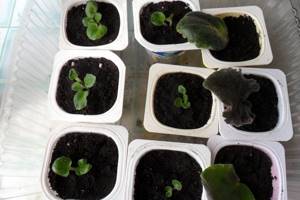
Episcia can be propagated by cuttings at any time of the year.
At first, the young plant should be protected from bright sun, drafts and temperature stress.
Reproduction from a leaf - video
Episcia Reproduction
Various methods are used to propagate episcia - by leaf, by lateral rosettes. In the first case, you will need a leaf from a strong, healthy plant, carefully separated and pre-dried.
Prepare a small plastic container with nutritious, loose soil. Plant the taken leaf to a depth of approximately 5 mm and leave for rooting for 4-8 weeks.
If the episcia bushes have grown greatly, it can be propagated by lateral rosettes. This is best done when replanting the plant, carefully separating the side shoot from the mother flower. They need to be immediately transplanted into separate plastic containers with nutrient soil.
How to root episcia without separating it from the mother plant:
- Place the lower parts of the side shoots in a bowl of water, without separating them from the mother trunk. After the roots appear, cut the rosettes from the shoot and replant them in the soil.
- Bury the side rosette in a small container located next to the mother plant. Cut off the shoots after they begin to actively grow and transplant them into separate pots.
The least effective method of propagating episcia is the seed method, as it is quite labor-intensive and time-consuming.
How to make Episcia bloom
This tropical beauty has a long flowering period - from April to October. But it is necessary to care for it and create optimal conditions for its growth and formation of buds.
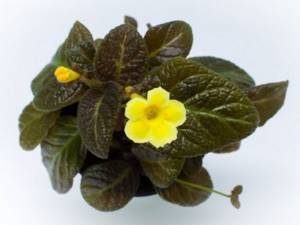
Good care is the key to flowering
- For Episcia, which does not like intense sunlight, it is necessary to provide diffused light - this will have a beneficial effect on flowering.
- You should not overfeed the plant - on overly fertilized soil it will grow leaf mass and will not bloom.
- Lack of moisture and dry soil can also be the reasons for the lack of flowering.
- The desired temperature regime must be created - flower buds do not form at low temperatures.
- Provides lush flowering and timely pruning of numerous shoots.
Care errors
By carefully examining the flower, you can immediately determine from it what mistakes were made in its care.
Possible problems - table
| Care errors | How to fix the situation |
| The appearance of dark spots on the leaves. | Moisten the substrate with warm water only. |
| Yellowing of leaves. | Maintain a humid atmosphere, water on time and do not overfeed. |
| The presence of a gray coating on the leaves. | Do not forget to ventilate the room or completely replace the soil. |
| The tips of the leaves dry out. | Avoid dry air, move the pot away from heating appliances. |
| The leaves begin to curl. | Carry out proper watering depending on the season. |
| The color of the leaves becomes faded, the flowers dry out. | Protect the plant from direct sunlight. |
| Sparse flowering, strong elongation of stems. | Move the flower closer to the light or use additional artificial lighting. |
Diseases and preventive measures: why a plant can become ill
Healthy episcia rarely get sick. However, they can become infected from other indoor plants. The greatest danger is represented by aphids, mealybugs, and root nematodes.
Diseases and preventive measures - table
| Pest\disease | Symptoms of the lesion | Prevention | Treatment |
| Aphid | Prefers to settle on buds, shoots and leaves. The insect feeds on the sap of the plant, the leaves wither and curl, and the shoots dry out. |
|
|
| Chervetsy | White lumps similar to cotton wool form on the foliage. Sucking insects inhibit plant growth, cause yellowing and drying of leaves, and the formation of a gray coating on them. |
|
|
| Nematodes | Roundworms damage the integrity of the roots and lead to their death. infected plants grow poorly and leaves begin to curl. |
|
|
| Root rot | The fungus dissipates in moist environments. The leaves are withering. The roots become soft and gradually rot. |
|
|
Diseases and pests
Episcia is quite resistant to parasites and diseases of indoor plants, but if you do not follow the rules of its maintenance, you may encounter some of them.
| Diseases and pests | Causes | Symptoms | Prevention and treatment |
| Aphid | Infected soil, open windows, proximity to an infected plant | Lethargy, small punctures on the leaves and stems, buds become deformed, ants appear | Isolate the flower, find the female and destroy it. If this is not possible and the colony is already large, it should be treated with Fitoverm, Iskra or Inta-Vir. |
| Thrips | High air temperature and insufficient humidity | Stains, holes, silvery coating. Insects are gray or black | Comply with the conditions of detention. If infected, treat the flower with Actellik or Aktara. But with this method, the leaves will suffer from moisture. An alternative option is to purchase the predatory mites Amblyseius andersoni, Amblyseius californicos or Amblyseius cucumeris. They will exterminate the parasite population, after which they themselves will die. |
| Shchitovka | Brown insects on the bottom of the leaf blade. Leaves turn yellow and fall off | ||
| Mealybug | White cotton wool-like sticky discharge | ||
| Root nematodes | Using contaminated soil, proximity to a diseased plant | Lethargy, curling leaves, yellow or brownish thickening on the roots, a large number of thread-like roots | Disinfect the soil before planting and equipment, isolate infected plants in a timely manner. It is impossible to save the plant. |
| Root rot | Excessive watering, insufficient lighting, low temperature | Lethargy, softening of stems | Follow the recommendations on the conditions of detention. It is difficult to save a plant; it is better to take cuttings and grow a new one. Boil the pot and throw away the soil. |
It doesn’t matter how you plan to grow the plant: in a terrarium, mini-greenhouse, on a windowsill or hanging against a wall, caring for it will not be difficult. It is enough to regularly put into practice the recommendations and arrange preventive examinations.
